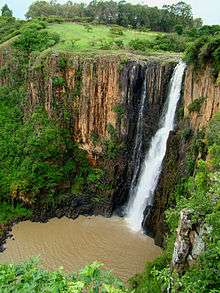Howick Falls
| Howick Falls | |
|---|---|
 Howick Falls in November 2009 | |
| Location | Howick, KwaZulu-Natal, South Africa |
| Coordinates | 29°29′12″S 30°14′20″E / 29.48667°S 30.23889°ECoordinates: 29°29′12″S 30°14′20″E / 29.48667°S 30.23889°E |
| Total height | 364 feet (111 m) |
| Number of drops | 1 |
| Watercourse | Mgeni River |
_pg117_Howick_Falls%2C_Natal.jpg)
Howick Falls is a waterfall in Howick, KwaZulu-Natal Province, South Africa. The waterfall is approximately 95 m in height (310 feet) and lies on the Umgeni River. The Zulu people called the falls KwaNogqaza, which means "Place of the Tall One".
Identified geographical feature
The falls were most likely first seen by European explorers in the early 19th century. However the KwaZulu-Natal province has known human occupation for well over 30,000 years and it is likely that it was a well known site prior to any western influence, given the rich legend surrounding the area.
Human interaction
Many people have been swept over the falls, especially in the pioneer days of the province, as some settlers thought the easiest place to cross the river was just above the falls. There have been a recorded 40 deaths surrounding Howick falls with the first recorded death occurring in 1851. Most of these have been recorded as suicides but accidents and murder have also been known to happen, contributing to if not maintaining the local legendary status of the falls. In 1999, Jeb Corliss had a near-fatal BASE jump into the waterfalls where his chute opening went asymmetric and he could not avoid flying into the downpouring water.[1]
Myth & folk-lore
According to local legend, the pool at the bottom of the falls is the residence of the Inkanyamba, a giant serpent-like creature. According to lore only sangomas can safely approach the falls and then only to offer prayers and other acts of worship to the inkanyamba, ancestral spirits and the 'Great God'.
Tourism
Despite, or perhaps because of its chequered history, kwaNogqaza has become a principal tourist attraction for the KwaZulu-Natal midlands.
See also
References
- "Howick Falls in the World Waterfall Database". Retrieved 2009-05-19.